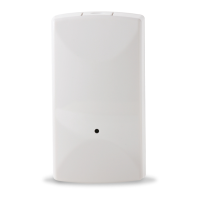Page 1 of 2
This sensor is a Z-Wave enabled device (interoperable, two-way RF mesh networking technology) and is
fully compatible with any Z-Wave enabled network. The Z-Wave wireless communication protocol
allows for Z-Wave devices from different manufacturers to operate in the same Z-Wave network. The
sensor detects deviations from the angle of its resting position. The tilt sensor is ideal for placement on
garage doors as the sensor will begin to rotate when the door is opened.
For indoor use only
Operating Frequency: 908.42 MHz
Operating Range: Up to 100 feet line-of-sight
Operating Temperature: 0⁰C to 49⁰C
Battery: 3 Volt CR123A Litium Ion
Installation begins by including the tilt sensor into a Z-Wave network. Inclusion is the process of adding
a new Z-Wave sensor to an existing Z-Wave network. If you are setting up a Z-Wave network for the
first time, please refer to the installation guide provided by the manufacturer of your Z-Wave controller
before installing the tilt sensor. When a Z-Wave network is in place, you are ready to include the sensor.
Mount the sensor in the desired final location before including it into the network. This will ensure that
the sensor is in communication range of other Z-Wave devices.
The sensor is in the upright position when the LED is slightly closer to the ground. If the sensor is
mounted right-side-up, the case should be wider at the top than it is at the bottom. Once the sensor is
mounted, follow the controller instructions and place the controller into “inclusion mode.” With the
controller in inclusion mode, insert the battery into the tilt sensor. Upon receiving power, the tilt sensor
will send out a Z-Wave message to the controller requesting to be included.
If inclusion was successful, the LED will be off. If inclusion was not successful, the LED will flash and
the inclusion process must be repeated. Repeat the inclusion process until the sensor has been
successfully included.
If the inclusion process continues to fail, it is possible that the sensor has already been included in a
different Z-Wave network. In this case, follow the procedure in the section titled “Exclusion” to exclude
the sensor. The inclusion process should work after the exclusion process has been completed.
Tilt Sensor
Installation & Operation Manual

